ARCHIVED - Status of Women Canada - Report
 This page has been archived.
This page has been archived.
Archived Content
Information identified as archived on the Web is for reference, research or recordkeeping purposes. It has not been altered or updated after the date of archiving. Web pages that are archived on the Web are not subject to the Government of Canada Web Standards. As per the Communications Policy of the Government of Canada, you can request alternate formats on the "Contact Us" page.
2010-11
Departmental Performance Report
Status of Women Canada
The original version was signed by
The Honourable Diane Finley
Minister of Human Resources and Skills Development
The Honourable Rona Ambrose
Minister of Public Works and Government Services and Minister for Status of Women
Contents
- Minister’s Message
-
Section I – Agency Overview -
1.1 Raison d’Être and Responsibilities - 1.2 Strategic Outcome and Program Activity Architecture
- 1.3 Organizational Priorities
- 1.4 Risk Analysis
- 1.5 Summary of Performance
- 1.6 Expenditure Profile
- 1.7 Estimates by Vote
-
Section II – Analysis of Program Activities by Strategic Outcome -
2.1 Program Activity: Strategic policy analysis, planning and development - 2.2 Program Activity: Women’s participation in Canadian society
- 2.3 Program Activity: Internal services
-
Section III – Supplementary Information -
3.1 Financial Highlights - 3.2 Financial Statements
- 3.3 List of Supplementary Information Tables
-
Section IV – Other Items of Interest
Minister’s Message
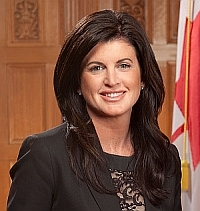 As Minister for Status of Women, I am honoured to present Status of Women Canada’s 2010–2011 Departmental Performance Report.
As Minister for Status of Women, I am honoured to present Status of Women Canada’s 2010–2011 Departmental Performance Report.
Status of Women Canada continues to achieve concrete results for Canadians, advancing equality for women in three priority areas: ending violence against women and girls; improving women’s economic security and prosperity; and promoting women’s leadership and decision-making roles. It also continues to collaborate with a range of partners to fulfil its mandate and meet the Government of Canada’s priorities for women and girls.
Status of Women Canada’s achievements over the past year are significant. They include the Blueprint Projects initiative – an innovative response to the Government of Canada’s goal of streamlining practices and providing greater flexibility to community organizations. The Blueprint Projects are a series of ready-made project models that enable Canadian organizations to address pressing issues facing Canadian women and girls.
Status of Women Canada was also the lead in the collaborative effort across government to produce Statistics Canada’s sixth edition of Women in Canada. This invaluable resource provides key information on the situation of women in areas such as economic security, violence, access to education and career opportunities, and data on specific groups, such as immigrant and Aboriginal women.
Canada will play a lead role in advancing a United Nations Resolution to proclaim an International Day of the Girl. I obtained unanimous support from the House of Commons when I announced the news on International Women’s Day, celebrated in Canada under the theme “Girls’ Rights Matter.”
However, while there is progress in many areas, violence against women and girls – and certain groups in particular – persists. That is why, over the past year, we have placed particular emphasis on addressing the systemic roots of violence, including targeting the heightened vulnerability of Aboriginal women. For example, Status of Women Canada supported a variety of projects, such as those that empower immigrant girls and young women and address such issues as honour-related violence; reducing violence against Aboriginal women and strengthening their communities; and addressing safety and security concerns for women with disabilities.
I have seen first-hand the benefits that our efforts have achieved for women and girls, and I am confident that we will continue to see positive results for all Canadians. Together we can achieve our vision of a society in which women and men, boys and girls live free of violence, benefit equally from Canada’s economic prosperity and share fully in the leadership of our country.
Rona Ambrose, P.C., M.P.
Minister for Status of Women
Section I – Agency Overview
1.1 Raison d’Être and Responsibilities
The Office of the Coordinator, Status of Women, became a departmental agency of the federal government on April 1, 1976. The legal mandate of Status of Women Canada is “to coordinate policy with respect to the status of women and administer related programs” (Policy authority – Order in Council 1976–779).
To fulfil this mandate, Status of Women Canada (SWC) works with partners such as federal departments and agencies, provincial/territorial governments, as well as members of the private and voluntary sectors. It also works with other key players to assist in meeting Canada’s international obligations.
In its strategic policy role, SWC fosters information exchange and collaborative interventions, and provides expert advice to federal organizations on long-standing and emerging issues, opportunities and best practices to help advance the full participation of women in Canadian society.
SWC leads the process of implementing gender-based analysis (GBA)1 by helping build organizational capacity, supporting federal organizations in their efforts to make GBA part of their regular practice and assisting in ensuring accountability for gender equality. For more information, see: Gender-based Analysis and Strategic Policy (http://www.swc-cfc.gc.ca/pol/gba-acs/index-eng.html).
SWC, through the Women’s Program, plays a vital role in supporting the work of women’s and other Canadian organizations to improve women’s economic and social conditions and to increase their participation in democratic life. These projects, many taking place at the community level, allow organizations with the relevant expertise to deliver projects that are appropriate to their communities. SWC continues to play a coordinating role among the organizations, encouraging partnerships where focus and approaches are similar. For more information, see: Funding (http://www.swc-cfc.gc.ca/fun-fin/wcf-fcf/index-eng.html).
In fulfilling its mandate, SWC takes into consideration the opportunities associated with Canada’s progress on advancing equality for women, while focusing its efforts where the need is greatest. As such, in 2010–2011, it maintained the three priority areas, ensuring its policy work and program investment are directed to those areas where gender equality gaps exist and paying particular attention to the challenges faced by women from diverse backgrounds.
SWC’s head office which also houses the Ontario regional office is located in the National Capital Region. Other regional offices are located in Moncton (for the Atlantic Region), Montreal (for Quebec and Nunavut) and Edmonton (for the West, Northwest Territories and Yukon). (http://www.swc-cfc.gc.ca/)
1.2 Strategic Outcome and Program Activity Architecture
The Program Activity Architecture (PAA) below displays SWC’s strategic outcome, expected results, program activities and sub-activities. As shown in the PAA, SWC has a single strategic outcome which is supported by the two program activities. As an inventory of activities, the PAA shows the relationship between the two program activities, the linkages between their expected results and how these results contribute to the agency’s strategic outcome. It also serves to report on how program activities are managed and resources invested to achieve long-term and enduring benefit for Canadians.
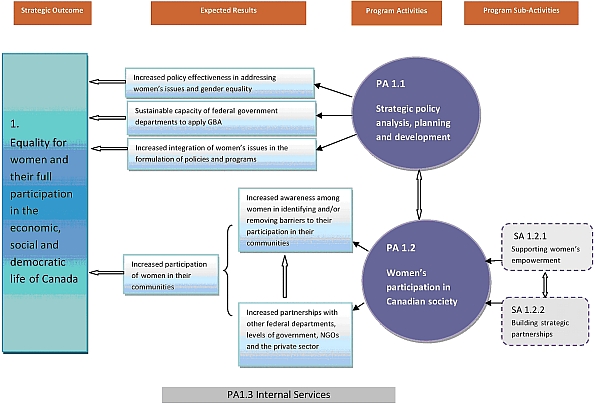
1.3 Organizational Priorities
| Priority | Type | Strategic Outcome |
|---|---|---|
| Strengthen implementation and use of gender-based analysis (GBA) | Ongoing | Equality for women and their full participation in the economic, social and democratic life of Canada |
| Status | ||
|
Met All
|
||
| Priority | Type | Strategic Outcome |
| Strategies to end violence against women and girls, including Aboriginal women and girls | Ongoing | Equality for women and their full participation in the economic, social and democratic life of Canada |
| Status | ||
|
Met All
|
||
| Priority | Type | Strategic Outcome |
| Financial and professional assistance for projects to address women’s economic security and encourage women in leadership roles | Ongoing | Equality for women and their full participation in the economic, social and democratic life of Canada |
| Status | ||
|
Met All
|
||
| Priority | Type | Strategic Outcome |
| Corporate Risk Profile | Previously committed | Equality for women and their full participation in the economic, social and democratic life of Canada |
| Values and Ethics | Previously committed | |
| Audit and Evaluation |
New |
|
| Status | ||
|
Mostly Met
|
||
1.4 Risk Analysis
Strategic Context
Although Canada is making considerable strides toward gender equality, particularly in areas such as the labour market2, workforce representation3, employment rate4 and entrepreneurship5, there are still areas where more work needs to be done. There are persistent gaps, for example, between women and men’s economic situation (e.g., wage gap, concentration in traditional jobs) and in their representation in leadership positions (where women remain under-represented). In addition, violence against women and girls continues to be a pressing health, social and criminal justice issue.
The existence of these gaps across social and economic domains reinforces the fact that the achievement of gender equality in Canada is a shared responsibility across federal departments and agencies, between various levels of government, and with different stakeholders, including civil society. For its part, SWC is focusing its efforts on addressing gaps specifically related to women’s economic security, promoting women in leadership positions and addressing key issues related to violence against women and girls.
Operating Environment
SWC undertook efforts to address challenges identified in the 2010–2011 Report on Plans and Priorities related to a corporate risk profile, values and ethics code, and audit and evaluation. Specifically, SWC completed an initial corporate risk profile (CRP) in 2010–2011 as well as a Values and Ethics Code for the organization. The audit and evaluation function has been strengthened while the summative evaluation of the Women’s Program will be completed in 2011–2012.
In 2010–2011, SWC’s operational and management priorities were implemented with measurable results, and potential risks were managed using various strategies. As SWC continues to develop its risk management capacity, the agency has ensured that risk is understood, communicated
and integrated in its decision-making processes and operational activities.
1.5 Summary of Performance
| Planned spending | Total authorities | Actual spending |
|---|---|---|
| 30.8 | 31.7 | 30.2 |
| Planned | Actual | Difference |
|---|---|---|
| 94 | 92 | 2 |
| Performance indicators | Targets | 2010–2011 Performance | ||||
|---|---|---|---|---|---|---|
| 1% increase per year |
In 2010–2011, SWC contributed to this strategic outcome: | |||||
| Representation of women in senior decision-making positions in the public and private sectors |
|
|||||
| Representation of women in the labour market, including access to support programs and services for entrepreneurship initiatives |
|
|||||
| Participation of women in political processes/systems at the local, provincial and federal levels |
|
|||||
| The 2010–2011 performance analysis shows steady progress toward this strategic outcome, as demonstrated by the gains made in women’s representation in the labour market, workforce and women’s participation in leadership and decision making roles. However, gender equality gaps persist in key areas. While this
strategic outcome cannot be achieved solely by SWC, the agency continues to contribute toward its realization through its two program activities. |
||||||
| Program activity | ($ millions) | Alignment to Government of Canada outcomes |
||||
| 2009 –10 Actual spend- ing |
2010–20116 | |||||
| Main esti- mates |
Plan- ned spend- ing |
Total author- ities |
Actual spend- ing |
|||
| Strategic policy analysis, planning and development | 1.6 | 1.8 | 1.8 | 2.1 | 2.0 | Government Affairs |
| Women’s participation in Canadian society | 23.4 | 25.1 | 25.1 | 25.4 | 22.7 | Economic Affairs |
| Total | 25.0 | 26.9 | 26.9 | 27.5 | 24.7 | |
| Program activity | ($ millions) | |||||
| 2009 –10 Actual spend- ing |
2010–2011 | |||||
| Main esti- mates |
Plan- ned spend- ing |
Total author- ities |
Actual spend- ing |
|||
| Internal services | 6.6 | 3.9 | 3.9 | 4.2 | 5.5 | |
In comparison with Planned Spending, the increase in Total Authorities is explained by the inclusion of the 2009–2010 operating budget carry forward, paylist expenditures, funding received through the Supplementary Estimates B and the Employee Benefit Plan adjustment.
The difference between total authorities and actual spending includes $448 thousand in frozen allotments which represents funds withheld by Treasury Board and which cannot be spent by Status of Women Canada.
1.6 Expenditure Profile
Departmental Spending Trend
In 2010–2011 SWC spent a total of $30.2 million to carry out its program activities, to achieve expected results and to advance toward its planned strategic outcome.
The increases in Main Estimates are due to additional grant and contribution funding from Budget 2007 and re-profiled funding from 2008–2009.
The decrease in total authorities is due to the sunsetting of a re-profiled grant and contribution funding.
Spending Trend ($ millions)
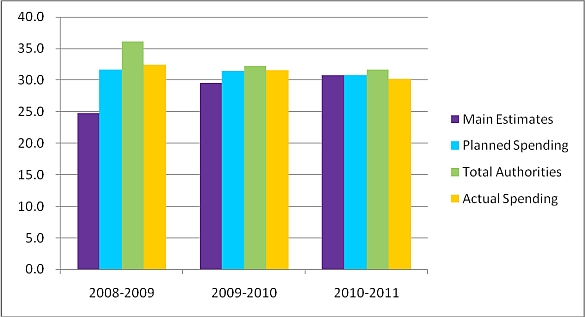
1.7 Estimates by Vote
For information on SWC’s votes and/or statutory expenditures, please see the 2010–2011 Public Accounts of Canada (Volume II) publication which is available at: http://www.tpsgc-pwgsc.gc.ca/recgen/txt/72-eng.html.
Section II – Analysis of Program Activities by Strategic Outcome
Strategic Outcome: Equality for women and their full participation in the economic, social and democratic life of Canada
SWC’s strategic outcome – a long-term, enduring benefit for Canadians – is achieved through the collective efforts of diverse players in the public, private and voluntary sectors. Given its mandate, SWC has a key role in the realization of this outcome which is supported by the agency’s two program activities.
To assess progress toward this outcome, SWC uses performance indicators and targets that demonstrate increased representation of women in key areas, including the labour market and workforce, entrepreneurship and in leadership and in decision-making roles. The agency is currently examining ways to improve performance reporting and will update its performance measurement framework accordingly, building, in part, on the findings of the Women’s Program evaluation.
2.1 Program Activity:
Strategic policy analysis, planning and development
Program Activity Description
This program activity develops strategic policy analysis, advice, and tools to support federal departments and central agencies in identifying policy priorities and integrating gender-based analysis in existing and proposed policies, programs and initiatives. This is done through collaboration with other federal departments, provincial-territorial governments, academic institutions, civil society, and key international partners. The program activity’s contribution to the strategic outcome is by way of enabling and supporting federal organizations to develop policies, programs and initiatives that integrate gender considerations, thereby supporting equality for women and their full participation in the economic, social and democratic life of Canada.
| 2010–11 Financial resources ($ millions) |
2010–11 Human resources (FTEs) |
|||||||
|---|---|---|---|---|---|---|---|---|
| Planned spending |
Total authorities |
Actual spending |
Planned | Actual | Difference | |||
| 1.8 | 2.1 | 2.0 | 15 | 17 | (2) |
|||
| Expected results |
Performance indicators |
Targets | Performance status |
|||||
| Increased policy effectiveness in addressing women’s issues and gender equality | Number of departments that respond to women’s issues effectively through policy/program formulation and implementation | 3–5 departments per year |
Met All | |||||
| Sustainable capacity of federal government departments to apply GBA | Percentage of other government departments with increased capacity to incorporate GBA into their policy and program activities | 3–5 departments per year |
Met All | |||||
| Increased integration of women’s issues in the formulation of policies and programs | Number of new and improved policies and programs that respond to women’s issues | 3–5 policies per year |
Met All | |||||
Performance Summary and Analysis of Program Activity
Sustainable Capacity of Federal Government Departments to Apply GBA: In spring 2009, the Office of the Auditor General reported on its review of the practice of GBA within six departments and the three central agencies, Treasury Board Secretariat (TBS), Privy Council Office (PCO) and Finance (the latter as a department and central agency). Following the Audit, SWC, TBS and PCO tabled the Departmental Action Plan on Gender-Based Analysis (GBA) with the Standing Committee on Public Accounts.
The year 2010–2011 was critical to SWC’s role in enlisting leadership and support for the practice of GBA in federal organizations. Priority was given to the multi-phased implementation of the Departmental Action Plan on GBA. While the focus was on the six departments and three central agencies audited, outreach was broadened to allow more federal organizations7 to fulfil the expectations of the Action Plan. The Action Plan provides accountability measures for GBA implementation and establishes a standard that requires federal organizations to make GBA a sustainable practice; to pilot GBA on a project to be showcased internally and to report on their overall efforts to strengthen the practice of GBA. SWC plays a lead role in guiding and facilitating GBA implementation processes within federal departments and agencies while the PCO and TBS perform challenge roles regarding evidence of GBA in Cabinet document, such as memoranda to Cabinet and Treasury Board submissions.
Throughout the reporting period, targeted efforts were made to improve communications, clarify expectations and increase accountability for GBA across the federal family. Panel presentations were organized in collaboration with PCO and TBS. In addition, face-to-face meetings, workshops, presentations, and interdepartmental meetings, involving working level and senior management, helped to guide and inform organizations’ GBA implementation processes.
In summer/fall 2010, the departments that participated in the first phase of the Action Plan submitted to SWC a detailed self-assessment on the various stages of development of their GBA institutional capacity. Findings from these self-assessments were reflected in the Interim Status Report on the Implementation of the Departmental Action Plan (http://www.parl.gc.ca/Content/HOC/Committee/403/PACP/WebDoc/WD4595936/Action_Plans/43-Status of Women Canada-e.htm), tabled by SWC in December 2010 at the request of the Standing Committee on Public Accounts.
At the end of the first phase of the GBA Action Plan, SWC, in collaboration with PCO and TBS, determined that four of the six audited departments had successfully completed their implementation process and achieved greater capacity to conduct and document GBA. The remaining two departments succeeded in partially completing their implementation processes and have joined the second phase of implementation (2011) to complete their GBA ‘pilot’ initiative and self-assessment.
SWC also provided GBA advice, tools and support services to approximately 20 other departments and agencies seeking guidance on integrating GBA. This support was both at the institutional level and in specific strategic documents such as memoranda to Cabinet. SWC also extended its outreach to specific professional communities within the federal government. Given their critical role in the policy and program development process, priority was given to the research and evaluation communities. For example, SWC co-sponsored with TBS a GBA presentation to Heads of Evaluation (January 2011).
SWC continued to chair meetings of the Interdepartmental Committee on GBA to improve communications and keep federal organizations updated on the GBA implementation progress. The committee also served to clarify expectations, provide a forum for exchanging information on respective departmental activities/issues related to GBA, respond to challenges and questions, and receive feedback on GBA products in development.
In 2010–2011, SWC undertook a review of its tools and training, building on a commitment to integrate better elements of intersectionality 8 in the GBA process. SWC established an interdepartmental working group on GBA tools – which reviewed and critiqued the new tools in various stages of development.
Major work was undertaken with key federal partners during 2010–2011 to develop a new online GBA training course. SWC is examining options for the possible delivery of this training through an online platform. SWC also continued to
support departments with a pool of qualified GBA trainers, free training materials and assistance in developing case studies for use in their GBA courses. In addition, SWC revised its training materials to provide a one-day “Introduction to
GBA” workshop. The first workshop, delivered in March 2011, received positive feedback from participants and will continue into the next reporting period.
Increased Integration of Women’s Issues in the Formulation of Policies and Programs: In its policy role, SWC continued to act as a knowledge broker, providing information, advice and support to departments and facilitating partnerships, particularly in areas of importance to women and gender equality:
- In 2010–2011, SWC spearheaded the collaborative efforts of 18 other federal organizations to leverage financial support for Statistics Canada’s sixth edition of Women in Canada, a Gender-based Statistical report.
- The agency saw an increased level of interest among and engagement by departments with an economic mandate, including: Public Works and Government Services Canada, Human Resources and Skills Development Canada, Indian and Northern Affairs Canada and Natural Resources Canada, to name a few.
- SWC continued to work with key stakeholders, raising awareness on the gendered dimensions of entrepreneurship to help facilitate women’s access to procurement opportunities and non-traditional occupations. For example, SWC collaborated with INAC to co-host a national Roundtable on Gender and Economic Development, a key activity for implementing the Federal Framework for Aboriginal Economic Development.
- SWC continued to play a key role in addressing various forms of violence against women and girls. In 2010–2011, in partnership with the Public Health Agency of Canada, SWC developed information and resources to respond to priority areas identified by the interdepartmental Family
Violence Initiative. These priorities included the need to better understand: the nature, extent and particular context of violence against Aboriginal women in the three territories; how men and boys can be engaged in preventing violence against women and girls; and the focus of current federal efforts to address family violence.
- As co-chair of the forum of Federal–Provincial–Territorial (F/P/T) Ministers Responsible for the Status of Women, SWC continued to collaborate with provincial and territorial counterparts to address violence against women and girls at local, regional and national levels
and to enhance available data on the issue. This included work in the area of trafficking in persons to identify opportunities for prevention and awareness activities at various levels, to support and influence other departments’ efforts to address this issue, and to share best practices. To support Government of Canada efforts to address trafficking in persons, SWC provided a specific training session on Aboriginal women as part of the RCMP-led training for a range of criminal justice personnel.
- SWC also provided strategic advice, expertise and information to support both the work being led by Justice Canada to address the high number of missing and murdered Aboriginal women, and that of Justice Canada and Citizenship and Immigration Canada to address the emerging issue of honour-based violence. In June 2010, SWC also facilitated a discussion on the findings of the Sisters in Spirit initiative with F/P/T Ministers Responsible for the Status of Women.
- Internationally, SWC provided expertise relevant to its mandate to support the Department of Foreign Affairs and International Trade and the Canadian International Development Agency in advancing Canada’s foreign policy, meeting the country’s international obligations related to gender equality and continuing to support gender
equality in international documents and fora. The agency continued to co-lead with Foreign Affairs and International Trade Canada preparations for the 55th annual session of the United Nations Commission on the Status of Women, the principal global policy-making forum for gender equality.
As SWC continues its support and monitoring activities, early evidence demonstrates a growing interest in GBA among departments and agencies. This interest is further complemented by recognition within the federal administration that GBA is a
shared responsibility in which SWC, central agencies and federal departments have distinct roles, responsibilities and accountability.
2.2 Program Activity: Women’s participation in Canadian society
Program Activity Description
This program activity supports women’s full participation by addressing their economic and social situations and their participation in democratic life through financial and other support for projects. It also uses strategic partnerships that leverage resources, involving public institutions and non-governmental and other organizations.
| 2010–11 Financial resources ($ millions) |
2010–11 Human resources (FTEs) |
|||||||
|---|---|---|---|---|---|---|---|---|
| Planned spending |
Total authorities |
Actual spending |
Planned | Actual | Difference | |||
| 25.1 | 25.4 | 22.7 | 32 | 33 | (1) |
|||
| Expected results |
Performance indicators |
Targets | Performance status |
|||||
| Increased participation of women in their communities | Proportion of funded projects that demonstrate level of women’s participation in their communities | 10% of projects |
Met All | |||||
| Increased awareness among women in identifying and/or remobving barriers to their participation in their communities | Proportion of funded projects that demonstrate raised awareness or knowledge acquisition among women in identifying and/or removing barriers to their participation in their communities | 10% of projects |
Met All | |||||
| Increased partnerships with other federal departments, levels of government, non-governmental organizations and the private sector | Proportion of funded projects involving partners addressing women’s issues through joint projects | 10% of projects |
Met All | |||||
Performance Summary and Analysis of Program Activity
Increased Partnerships with Other Federal Departments, Levels of Government, Non-governmental Organizations and Increased Awareness Among Women in Identifying and/or Removing Barriers to Their Participation in Their Communities: In 2010–2011, SWC provided funding and other supports for projects designed to address barriers to women’s participation in Canadian society. Of the 315 projects funded during the reporting year, 70 were completed, 161 were ongoing and 84 were new projects. Total funding expended for these projects during the reporting year was $19,545,446.
The projects were diverse in nature and scope, targeted different population groups, addressed a variety of issues and applied varied strategies. SWC continued to support projects that promote the use of gender-based analysis and apply strategies that acknowledge the intersectionality of issues affecting women. All projects contributed to one or more of the SWC priority areas: improving women’s economic security and prosperity; ending violence against women and girls; and encouraging women and girls in leadership and decision-making roles.
SWC supports projects that work to increase and strengthen access to a range of opportunities, information, services, tools, etc. that can and do facilitate women’s participation in Canadian society. The performance analysis for this program activity shows that these strategies and supports are yielding concrete results in leveraging partnerships and raising awareness, thereby increasing women’s participation in their communities.
SWC continued to work on streamlining practices and providing greater program flexibility. The innovative Blueprint Projects were introduced during the reporting year. Through this initiative, SWC determined more specific funding priorities and invested strategically in areas where the need and the potential to achieve concrete and direct results were greatest. This approach is allowing SWC to test promising and innovative models, including demonstrating how they can be optimized with various population groups or in various settings. It also supports projects on new or emerging issues.
SWC also implemented a new continuous intake mechanism that allows organizations to submit proposals for funding throughout the year. The new mechanism allows for greater flexibility in responding to emerging issues, provides increased opportunities for funding partnerships, supports coherence of government action in addressing women’s
issues and increases the potential for sustainability of project outcomes.
2.3 Program Activity: Internal services
Program Activity Description
Internal Services are groups of related activities and resources that are administered to support the needs of programs and other corporate obligations of an organization. These groups are: Management and Oversight Services; Communications Services; Legal Services; Human Resources Management Services; Financial Management Services; Information Management Services; Information Technology Services; Strategic Planning and Reporting Services; Audit and Evaluation Services; Cabinet/Parliamentary Affairs Services; Real Property Services; Materiel Services; Acquisition Services; Services to the Minister for Status of Women; Travel and Other Administrative Services.
| 2010–11 Financial resources ($ millions) |
2010–11 Human resources (FTEs) |
|||||||
|---|---|---|---|---|---|---|---|---|
| Planned spending |
Total authorities |
Actual spending |
Planned | Actual | Difference | |||
| 3.9 | 4.2 | 5.5 | 47 | 42 | 5 | |||
Performance Summary and Analysis of Program Activity
In 2010–2011, SWC completed work on its corporate risk profile. The agency continued its efforts to put in place a robust integrated risk management framework to ensure that risk is taken into consideration in decision-making processes, annual planning and operational activities.
The agency has also finalized its Values and Ethics Code, which will be launched in 2011–2012.
The Summative Evaluation of the Women’s Program, launched last fiscal year, will be completed in 2011–2012.
Section III – Supplementary Information
3.1 Financial Highlights
The financial highlights presented within this Departmental Performance Report are intended to serve as an overview of the organization’s financial position and operations.
| ($ thousands) | |||
|---|---|---|---|
| % Change | 2009–10 | 2010–11 | |
| ASSETS | |||
| Financial assets | 17% | 3,539 | 4,126 |
| Non-financial assets | (17%) | 273 | 226 |
| Total Assets | 14% | 3,812 | 4,352 |
| LIABILITIES | |||
| Total Liabilities | 16% | 5,353 | 6,229 |
| EQUITY | |||
| Total Equity | (22%) | (1,541) | (1,877) |
| TOTAL | 14% | 3,812 | 4,352 |
| ($ thousands) | ||||
|---|---|---|---|---|
| % Change |
2009–10 | 2010–11 | Forecast 2010–119 |
|
| EXPENSES | ||||
| Total Expenses | (5%) | 32,895 | 31,400 | 32,266 |
| REVENUES | ||||
| Total Revenues | — | — | 0 | 0 |
| NET COST OF OPERATIONS | (5%) | 32,895 | 31,400 | 32,266 |
Total assets were approximately $4.4 million at the end of 2010–2011, a 14% increase over the previous year’s total. Of this amount, 94% or approximately $4.1 million is “Due from the Consolidated Revenue Fund”; 5% or approximately $0.2 million is “Tangible Capital Assets”; and 1% or $0.02 million is “Receivables and advances.”
In 2009–2010, SWC conducted a review of all its capital assets and associated amortization. Changes and corrections led to the continued decrease in SWC’s non-financial assets.
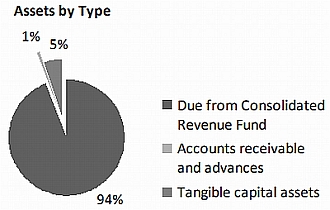
Total liabilities were approximately $6.2 million at the end of 2010–2011, a 16% increase from the previous year’s total. Accounts payable and accrued liabilities are the largest component of liabilities. Together they represent 73% of total liabilities.
The 16% increase is mostly explained by the addition of new accounts payable for transfer payments to different organizations.
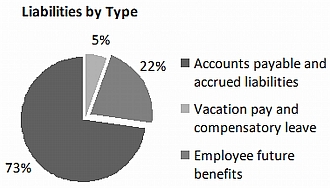
Total expenses for SWC were $31.4 million in 2010–2011, a 5% decrease from the previous year’s total. This decrease is mostly explained by SWC’s participation in government-wide reduction exercises, respecting the limits on travel, hospitality and conference spending and the sunsetting of a five-year transfer payment program in 2009–2010.
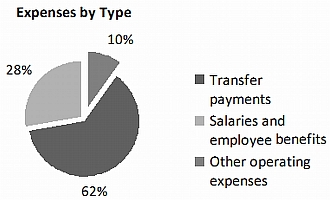
Comparison of Forecast Results (As Per the Organization’s 2010–2011 Future-oriented Financial Statements) and Actual Results: The organization’s final net cost for operations in 2010–2011 was approximately $866 thousand less than anticipated in the future-oriented financial statements included in SWC’s 2010–2011 Report on Plans and Priorities ($31.4 million versus $32.3 million). This represents a 3% variance and is explained as follows:
The future-oriented financial statements were prepared based on Parliamentary appropriations received as of the 2010–2011 Main Estimates. They did not consider expenditures as a result of resources received for the remainder of the year and/or a variation in voted resources for such items as:
- “carry-forward” amount from 2009–2010;
- funding received through Supplementary Estimates B; and
- maternity, severance payments and employee benefits plan.
Other explanations for the variance relate to unplanned lapses in both contribution funding and operating expenditures.
3.2 Financial Statements
For financial statements, please visit:
http://www.swc-cfc.gc.ca/account-resp/pr/fin/index-eng.html
3.3 List of Supplementary Information Tables
All electronic supplementary information tables in this Report can be found on the Treasury Board of Canada Secretariat’s website at:
http://www.tbs-sct.gc.ca/dpr-rmr/2010-2011/index-eng.asp
- User Fees Reporting
- Details on Transfer Payment Programs (TPPs)
- Response to Parliamentary Committees and External Audits
- Internal Audits and Evaluations
Section IV – Other Items of Interest
In 2010–2011, SWC carried out a number of communications activities to advance equality for women, particularly in the areas of: women’s economic security and prosperity, violence against women and girls, and women’s leadership and decision-making roles.
Commemorative Events: SWC promoted awareness of milestones in the history of women in Canada. The commemorative dates are: International Women’s Day (March 8), Women’s History Month (October), Persons Day (October 18) and the National Day of Remembrance and Action on Violence Against
Women (December 6). By highlighting these commemorative events, the agency helped educate Canadians about the challenges still facing women and girls in our society.
Governor General’s Awards in Commemoration of the Persons Case: SWC organized and facilitated the annual awards ceremony, which honours individual Canadians for their contributions to the goal of equality for women in Canada. The awards commemorate the 1929 legal victory that changed the course of
history for women in Canada. These awards bring attention to the important work being undertaken by the diversity of Canadians, in Canada.
Funding Announcements and Project Launches: SWC supported the Minister for Status of Women and other members of Parliament to reach out to Canadians and communicate key messages during public announcements and launches of projects that received SWC funding. Using a
variety of products and services, the agency communicated to Canadians its activities in its three priority areas: promoting women’s economic security and prosperity; ending violence against women and girls; and encouraging women to participate in leadership and decision-making roles.
Community Engagement: SWC supported the Minister for Status of Women and other officials in conceiving and carrying out roundtable meetings with groups and individuals. These events enabled the Minister to ensure that the government is responsive to the issues facing Canadian women and girls.
Organizational Contact Information
For financial information, contact:
Johanne Tremblay
A/Director, Corporate Services
Telephone: 613-995-3817
Fax: 613-947-6113
E-mail: Johanne.Tremblay@swc-cfc.gc.ca
For other information, contact:
Ainalem Tebeje
Manager, Corporate Planning and Reporting
Telephone: 613-995-1811
Fax: 613-947-0530
E-mail: Ainalem.Tebeje@swc-cfc.gc.ca
Footnotes to the Report
1 GBA is the process of examining a policy/program or initiative for its impact on women and men in all their diversity.
2 The labour market participation rate for women rose from 57% in 1996 to 62.6% in 2009.
3 Women represented 47.3% of the total workforce in 2009, up from 45.7% in 1999.
4 The employment rate for women increased by 17.4 percentage points, rising from 41.9% in 1976 to 59.3% in 2008.
5 Roughly one million women are self-employed. This figure is increasing, from 8.6% in 1976 to 11.9% in 2009.
6 Commencing in the 2009–1010 Estimates cycle, the resources for Program Activity: Internal Services are displayed separately from other program activities; they are no longer distributed among the remaining program activities, as was the case in previous Main Estimates. This has affected the comparability of spending and FTE information by program activity between fiscal years.
7 Non-audited departments included: Agriculture and Agri-Food Canada, Canada Economic Development for Quebec Regions, CanNOR, Canadian Museum for Human Rights, Industry Canada, Public Safety Canada, Public Prosecution Service of Canada, Public Works and Government Services Canada, Canadian Human Rights Commission, Natural Resources Canada, Rural and Co-operatives Secretariat, Public Health Agency Canada, Sport Canada, Telefilm Canada, Department of Fisheries and Oceans, Passport Canada, Department of Foreign Affairs and International Trade and the National Research Council.
8 Intersectionality seeks to examine gender inequality by considering how multiple and simultaneous forms of discrimination interact.
9 As per the organization’s 2010–2011 future-oriented financial statements.